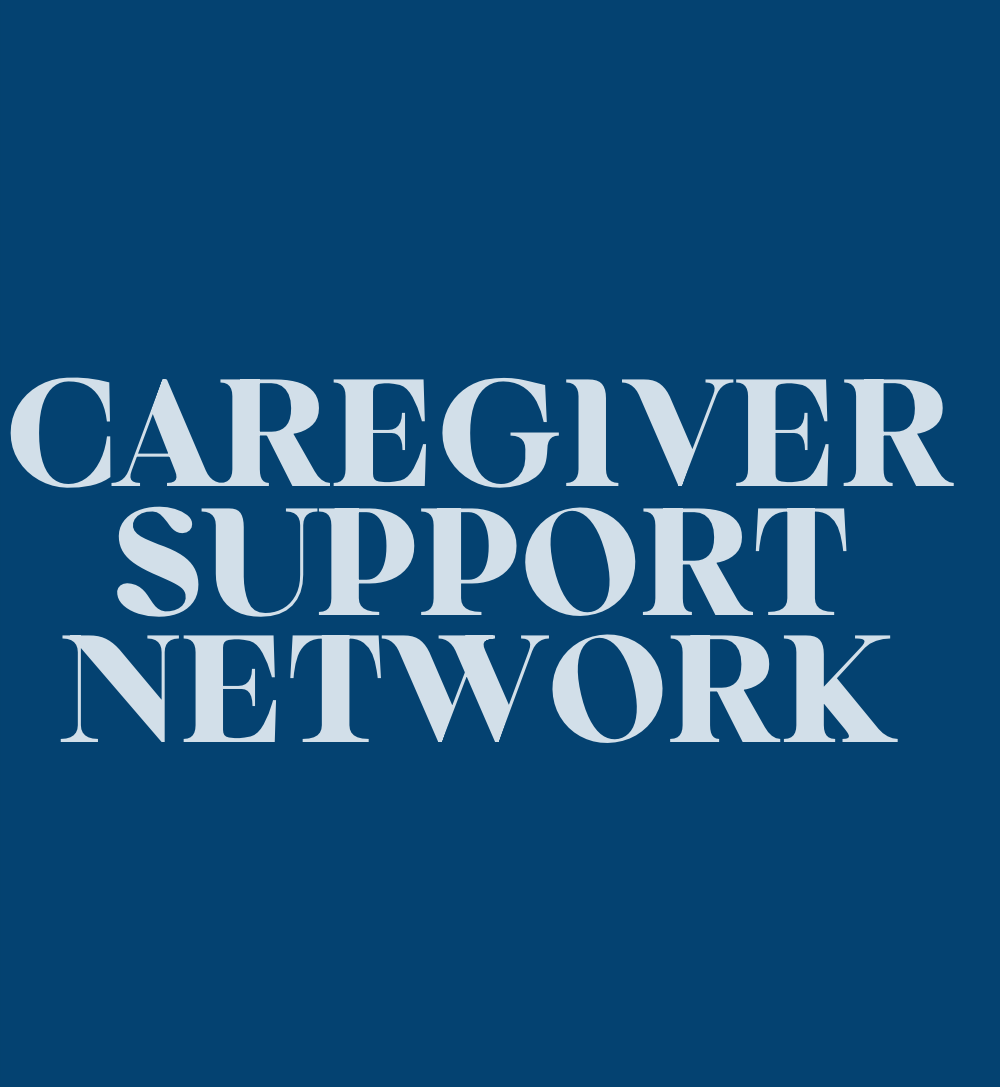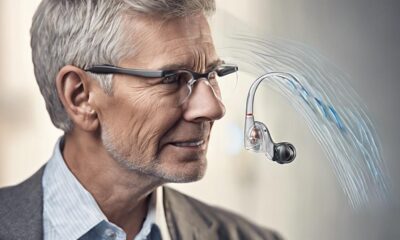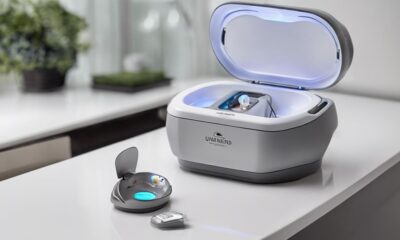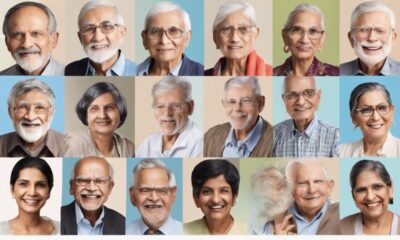Caregiver Support
What Are the 5 Newest Treatments for Sleep Apnea?
Get insights on the 5 newest treatments for sleep apnea, from innovative implants to non-invasive therapies, revolutionizing how we manage this common sleep disorder.

In considering the question about the 5 newest treatments for sleep apnea, let's look at innovative methods to manage this sleep disorder. Upper Airway Stimulation Therapy implants a device in the chest to gently stimulate and keep the airway open, reducing apnea events to a notable degree. Oral Negative Pressure Therapy creates negative pressure in the mouth to stabilize the upper airway, offering a non-invasive CPAP alternative. Nasal Expiratory Positive Airway Pressure Devices apply pressure during exhalation to maintain airway patency, enhancing sleep quality. Hypoglossal Nerve Stimulation activates throat muscles to prevent airway collapse, showing promising results. Myofunctional Therapy strengthens key muscles to address airway obstructions effectively. Explore further for detailed insights.
Key Takeaways
- Upper Airway Stimulation Therapy reduces apnea events with a small chest implant.
- Oral Negative Pressure Therapy stabilizes airway with oral cavity pressure.
- Nasal Expiratory Positive Airway Pressure Devices improve sleep quality non-invasively.
- Hypoglossal Nerve Stimulation prevents airway collapse with minimal implantation.
- Myofunctional Therapy strengthens muscles for reduced apnea events holistically.
Upper Airway Stimulation Therapy
We implant a small device under the skin in the upper chest to deliver mild stimulation, keeping the upper airway open during sleep for improved quality. This upper airway stimulation therapy is a safe and effective option for individuals with obstructive sleep apnea who are intolerant to CPAP.
By activating the device with a remote control, the therapy helps reduce the apnea-hypopnea index noticeably, from 29 to 9 events per hour after 12 months of consistent use. The procedure for implanting the device is typically done on an outpatient basis, making it convenient for patients.
With specific criteria such as age, BMI, and AHI range, candidates can benefit from this therapy, especially if CPAP hasn't been successful for them. Compared to CPAP, this therapy has shown higher compliance rates, low complication rates, and improved overall sleep quality.
It's important for individuals considering this therapy to consult with their healthcare providers to determine if they're suitable candidates for upper airway stimulation therapy.
Oral Negative Pressure Therapy
Oral negative pressure therapy, a novel approach in treating sleep apnea, involves utilizing a device to create negative pressure in the oral cavity during sleep. This therapy aims to stabilize the upper airway, reducing episodes of obstructive events that occur during sleep. Research has shown that oral negative pressure therapy can lead to a significant decrease in the apnea-hypopnea index (AHI) in individuals with obstructive sleep apnea.
Being a non-invasive alternative option, it may be suitable for those who struggle with or can't adhere to traditional CPAP therapy. The efficacy of oral negative pressure therapy in managing sleep apnea is being actively studied, showing promising results. This treatment provides a potential solution for individuals seeking a different approach to address their sleep apnea symptoms.
As ongoing research continues to explore its benefits, oral negative pressure therapy stands out as a valuable addition to the options available for those dealing with sleep apnea.
Nasal Expiratory Positive Airway Pressure Devices
Nasal expiratory positive airway pressure devices offer a new and effective treatment option for individuals with sleep apnea. These devices are non-invasive and work by applying pressure during exhalation to keep the airway open, aiding in managing obstructive sleep apnea. They can serve as an alternative to traditional CPAP therapy, aiming to improve sleep quality and reduce the apnea-hypopnea index. Research has shown promising results in using nasal expiratory positive airway pressure devices to enhance sleep apnea management.
| Key Points | Details |
|---|---|
| Treatment Type | Nasal Expiratory Positive Airway Pressure Devices |
| Invasiveness | Non-Invasive |
| Mechanism | Keeps Airway Open during Exhalation |
| Condition Targeted | Obstructive Sleep Apnea |
| Impact | Improves Sleep Quality, Reduces Apnea-Hypopnea Index |
These devices offer a practical and promising approach to addressing sleep apnea, providing individuals with an effective tool to enhance their sleep quality and overall well-being.
Hypoglossal Nerve Stimulation

Utilizing hypoglossal nerve stimulation presents a cutting-edge approach to managing obstructive sleep apnea by implanting a device that stimulates throat muscles and the tongue to keep the airway open during sleep. This treatment option is ideal for individuals who haven't responded well to traditional therapies like CPAP or oral appliances. It's usually considered when other methods haven't been effective in keeping the upper airway open during sleep, thereby improving breathing patterns.
Hypoglossal nerve stimulation works by activating the hypoglossal nerve, which controls the movement of the tongue and other throat muscles, preventing airway collapse and promoting uninterrupted breathing throughout the night. The implantation of the device is minimally invasive, and studies have shown promising results in reducing the frequency of apnea events and enhancing overall sleep quality.
If you have struggled with obstructive sleep apnea and traditional treatments haven't provided the desired relief, discussing hypoglossal nerve stimulation with your healthcare provider could be a valuable next step in managing your condition effectively.
Myofunctional Therapy
Exploring tongue and facial muscle strength and coordination through myofunctional therapy offers a targeted approach to treating sleep apnea. This therapy focuses on enhancing airway function by correcting oral habits, refining breathing patterns, and optimizing overall oral posture. Studies have shown that myofunctional therapy can effectively reduce the apnea-hypopnea index (AHI) by strengthening the key muscles involved in breathing and upper airway stability, ultimately decreasing collapsibility during sleep.
To investigate further the benefits and principles of myofunctional therapy, consider the following table:
| Myofunctional Therapy Benefits | Principles of Myofunctional Therapy |
|---|---|
| – Improves tongue muscle strength | – Corrects oral habits |
| – Enhances facial muscle coordination | – Refines breathing patterns |
| – Optimizes airway function | – Enhances upper airway stability |
Myofunctional therapy serves as a non-invasive treatment option that targets the root causes of airway obstruction in individuals with sleep apnea. By addressing muscle strength and coordination, this therapy offers a holistic approach to improving sleep quality and overall health.
Frequently Asked Questions
What Is the Most Successful Treatment for Sleep Apnea?
CPAP therapy stands as the most successful treatment for sleep apnea. It has been the gold standard for over 40 years, proven to reduce dementia and cognitive impairment risks linked to sleep apnea.
Long-term CPAP use also lowers heart disease and diabetes risks while improving breathing and overall sleep quality. Its effectiveness and benefits make CPAP therapy the top choice for managing sleep apnea successfully.
What Is the New Cure for Sleep Apnea?
We've discovered a cutting-edge solution for sleep apnea: the Inspire upper airway stimulation device. This FDA-approved innovation doesn't require a mask and involves implanting a device that stimulates airway muscles to stay open during sleep.
It's an excellent option for those who struggle with CPAP or oral appliances. Inspire therapy is most beneficial for individuals with a BMI under 32, offering improved sleep quality and reduced apnea events.
What Is the New Appliance for Sleep Apnea?
We've found the latest appliance for sleep apnea is the FDA-approved Inspire upper airway stimulation device. This maskless option internally stimulates airway muscles to maintain openness during sleep. It's ideal for those intolerant to CPAP, oral devices, or with a BMI under 32.
Inspire involves implantation and occasional battery replacement, providing an alternative to traditional CPAP therapy. This new treatment offers relief for individuals struggling with CPAP discomfort or non-compliance.
What Is the Permanent Solution for Sleep Apnea?
The permanent solution for sleep apnea is upper airway stimulation therapy. It involves implanting a small device under the skin to deliver mild stimulation, keeping the upper airway open during sleep.
This therapy offers consistent quality sleep, improved health, reduced daytime sleepiness, and protection of memory function. It's safe and effective for many with obstructive sleep apnea.
Candidates must meet specific criteria, including age, CPAP failure, BMI, AHI range, recent sleep study, and airway anatomy.
Conclusion
To sum up, the latest treatments for sleep apnea offer new hope and relief for those struggling with this condition. With advancements in technology and therapy options like Upper Airway Stimulation and Hypoglossal Nerve Stimulation, individuals can now find effective solutions to improve their quality of sleep and overall well-being.
These treatments are like shining beacons in the night, guiding individuals towards a brighter, more restful future. It's time to take charge of your sleep health and explore these innovative options.
Albert brings a wealth of knowledge and expertise to our writing team. With a background in caregiving and a deep understanding of the challenges faced by caregivers, Albert’s writing resonates with authenticity and empathy. He is committed to delivering high-quality content that empowers and supports caregivers on their journey.
Caregiver Support
Comprehensive Guide to Managing and Treating Varicose Veins
In-depth insights on managing varicose veins offer crucial strategies for effective treatment and long-term relief.

Varicose veins, common in the legs, are treatable using various methods. Causes include factors like obesity, family history, and prolonged standing which elevate vein pressure. Symptoms like pain, itching, and swelling signal the need for evaluation. Exercise, weight loss, and compression stockings help manage symptoms conservatively. Procedures like laser ablation and sclerotherapy offer more crucial treatment. Monitoring outcomes is essential to prevent complications like ulcers. Essential prevention methods include compression stockings and maintaining a healthy weight. These strategies provide relief and improve long-term outcomes for managing varicose veins effectively.
Key Takeaways
- Regular exercise improves circulation and reduces varicose vein risk.
- Weight loss alleviates pressure on veins, easing symptoms.
- Compression stockings reduce swelling and discomfort.
- Interventional procedures like laser ablation offer effective treatment.
- Monitoring varicose veins and maintaining a healthy weight are crucial for long-term outcomes.
Etiology and Risk Factors
Varicose veins develop due to various risk factors, including chronic cough, constipation, family history of venous disease, female sex, obesity, and prolonged standing. When we stand for extended periods, the increased intravenous pressure can strain the veins, leading to their dilation and the formation of varicose veins.
Valvular dysfunction, which causes venous reflux, plays a vital role in this process. Factors like obesity contribute to the increased pressure on the veins, while chronic coughing or constipation can exacerbate the condition by putting additional stress on the venous system.
Additionally, a family history of venous disease can predispose individuals to developing varicose veins due to inherited factors affecting vein wall elasticity and valve function. Understanding these risk factors is essential in both preventing and managing varicose veins, highlighting the importance of lifestyle modifications and early intervention to mitigate the impact of these predisposing conditions.
Diagnosis and Evaluation

Upon initial evaluation, clinicians assess various factors to diagnose and evaluate potential varicose veins, considering symptoms, risk factors, and physical examination findings.
Patients may present with a range of symptoms such as pain, burning, itching, leg aching, fatigue, or swelling.
Clinical tests like the tap test and Perthes test are used to detect venous reflux in varicose veins, aiding in the diagnostic process. It's important to note that clinical tests have limited value in detecting reflux in varicose veins compared to other methods.
Symptoms of varicose veins can worsen with prolonged standing but often improve with leg elevation. Women are more likely than men to report symptoms of varicose veins, which can manifest as either unilateral or bilateral in presentation.
Conservative Treatment Options
In managing varicose veins, incorporating conservative treatment options is essential for improving symptoms and preventing further progression of the condition.
Here are some key strategies that can help in managing varicose veins effectively:
- Regular exercise: Engaging in activities like walking, cycling, or swimming can promote better circulation and reduce the risk of varicose veins worsening.
- Weight loss: Maintaining a healthy weight can alleviate pressure on the veins, easing symptoms and preventing complications.
- Compression stockings: Wearing these specialized stockings can help in reducing swelling and discomfort by supporting proper blood flow in the legs.
- Self-care practices: Simple habits like avoiding prolonged periods of sitting or standing, eating a balanced diet, and staying hydrated can aid in managing varicose veins.
- Compression therapy: This treatment method involves applying controlled pressure to the affected area, enhancing blood circulation and reducing swelling.
Interventional Procedures
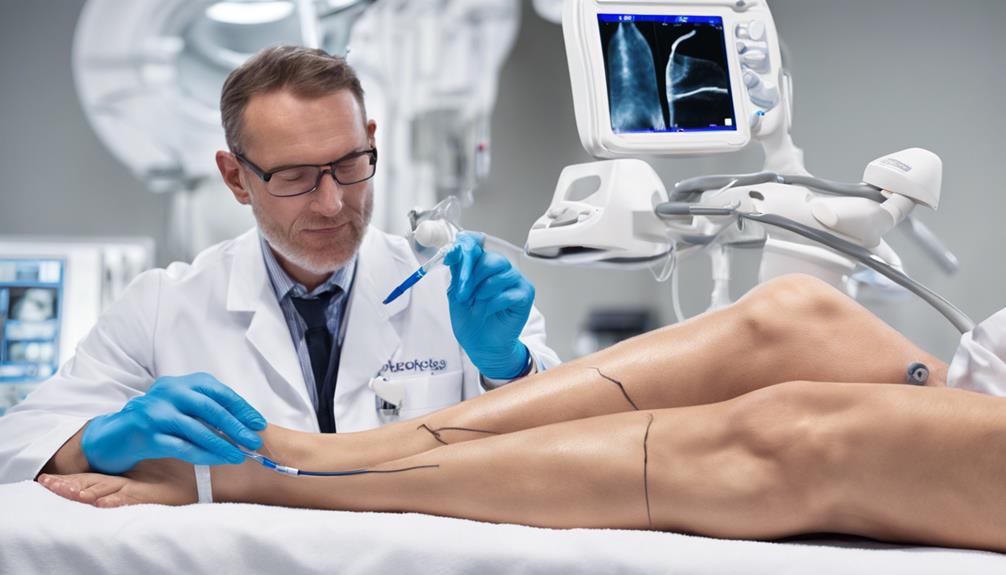
To address varicose veins effectively, medical professionals often employ interventional procedures such as endovenous laser ablation, radiofrequency ablation, and foam sclerotherapy.
Endovenous laser ablation uses laser energy to seal off the problematic vein, causing it to close and redirect blood flow.
Radiofrequency ablation, on the other hand, utilizes radiofrequency energy to heat and shut down the affected vein, guiding blood to healthier vessels.
Foam sclerotherapy involves injecting a foam solution into the vein, prompting it to scar and close, rerouting blood through better-functioning veins.
These minimally invasive procedures provide effective alternatives to traditional surgery for treating varicose veins. They offer shorter recovery times and fewer complications, making them favorable options for individuals seeking to address varicose veins without undergoing extensive surgical procedures.
Medical professionals consider these interventions when determining the most suitable treatment plan for managing varicose veins.
Outcome Data and Prognosis
Regularly monitoring varicose veins and understanding their outcomes is important for ensuring effective management and prognosis. When dealing with varicose veins, it's essential to take into account potential complications like venous ulcers and deep vein thrombosis, which can impact long-term outcomes.
Recurrence rates post-surgical treatment can range from 20% to 28%, highlighting the importance of ongoing care. To improve prognosis, implementing prevention methods such as wearing compression stockings, maintaining a healthy weight, and engaging in regular exercise is key. Lifestyle modifications, along with treatments like endovenous ablation and compression therapy, can markedly reduce symptoms and enhance overall long-term outcomes.
Primary care providers play a crucial role in educating patients about prevention strategies and managing varicose veins effectively. By working together and staying informed, we can aim for better outcomes and quality of life for individuals dealing with varicose veins.
Frequently Asked Questions
What Is the General Management for Varicose Veins?
We manage varicose veins with lifestyle changes like exercise, weight loss, and avoiding prolonged standing. Compression stockings improve circulation and reduce symptoms. Elevating legs reduces swelling. Consistent self-care practices such as exercise and weight management are essential.
What Is the Most Effective Treatment for Varicose Veins?
For varicose veins, the most effective treatment varies based on severity. Options include endovenous thermal ablation, sclerotherapy, surgical interventions like ligation, and newer techniques like VenaSeal. Combining treatments can offer thorough management.
What Are the Three E's for Varicose Veins?
When dealing with varicose veins, remember the three E's: Exercise, Elevation, and Elastic compression stockings. These simple steps improve circulation, reduce swelling, and provide support to prevent discomfort. Embrace the three E's for healthier legs.
What Is the Gold Standard Treatment for Varicose Veins?
Endovenous thermal ablation, like laser or radiofrequency ablation, is our go-to for varicose veins. It efficiently closes off problematic veins using heat, redirecting blood flow. This minimally invasive procedure boasts a success rate over 90%.
Conclusion
To sum up, managing and treating varicose veins is important for maintaining healthy circulation and preventing complications.
Remember to stay active, elevate your legs, and wear compression stockings to help improve symptoms.
If conservative treatments aren't effective, consult with a healthcare provider for further evaluation and possible intervention.
Just like a garden that needs regular care and attention to flourish, our veins also require proper care and maintenance to keep them healthy and functioning properly.
Albert brings a wealth of knowledge and expertise to our writing team. With a background in caregiving and a deep understanding of the challenges faced by caregivers, Albert’s writing resonates with authenticity and empathy. He is committed to delivering high-quality content that empowers and supports caregivers on their journey.
Caregiver Support
Understanding Compassion Burnouts Impact
Uncover the hidden dangers of compassion burnout and its impact on caregivers and patient care, leading to crucial insights for healthcare professionals.

Compassion burnout can harm caregivers and patient care. Symptoms of emotional exhaustion and irritability signal this issue. It leads to detachment and inefficacy at work. Combating burnout involves self-care strategies and setting limits. Balancing fatigue and satisfaction is crucial for well-being. Impacting job satisfaction, burnout affects caregiving quality. Recognizing signs early is essential to prevent escalation. By learning about compassion burnout's effects, you can understand its importance in healthcare.
Key Takeaways
- Compassion burnout impacts caregivers with emotional exhaustion and reduced empathy.
- It leads to decreased job satisfaction and feelings of inefficacy.
- Patients may receive less effective care due to caregiver detachment.
- Recognizing symptoms early can prevent escalation of compassion burnout.
- Professional Quality of Life Measure (ProQOL) evaluates caregiving aspects related to fatigue and satisfaction.
Definition of Compassion Burnout
Compassion burnout, or empathetic fatigue, occurs when caregivers experience a combination of burnout and secondary traumatic stress in their roles. This phenomenon is prevalent in caregiving environments and can lead to emotional exhaustion and a decline in the professional quality of life. Symptoms of burnout include feeling drained, less empathetic, easily irritable, and even physical ailments. The impact of compassion burnout goes beyond the individual caregiver; it affects the well-being of both patients and caregivers.
Recognizing and addressing compassion burnout early is important to prevent long-term negative effects. By acknowledging the signs and taking proactive steps, such as seeking support or adjusting workloads, caregivers can safeguard their mental and emotional health. Additionally, creating a supportive and open dialogue within caregiving teams can help in identifying and addressing compassion burnout collectively.
Understanding the definition of compassion burnout is the first step towards combating its effects on caregivers and the quality of care provided to patients.
Recognizing Symptoms and Warning Signs

In caregiving environments, it's important to be vigilant for signs and symptoms indicating compassion burnout. Symptoms of compassion burnout can include emotional exhaustion, reduced empathy, increased irritability, physical symptoms like headaches or stomach issues, and decreased job satisfaction. These symptoms may manifest as warning signs like chronic pain, apathy, lack of focus, agitation, and even violent thoughts.
Recognizing these warning signs early on is vital for preventing further escalation of compassion burnout. Additionally, compassion burnout can lead to detachment, cynicism, and a sense of ineffectiveness in providing care, which can negatively impact both the caregiver and the individuals receiving care.
Impact on Professional Quality of Life
Recognizing and addressing the impact of compassion burnout on professional quality of life is essential for maintaining well-being and resilience in caregiving roles. Compassion fatigue, the adverse aspect of professional quality of life, results from the emotional and physical exhaustion that caregivers experience when helping others. This can lead to decreased job satisfaction and feelings of inefficacy.
On the other hand, compassion satisfaction refers to the fulfillment and happiness derived from making a difference in others' lives. Striking a balance between compassion fatigue and compassion satisfaction profoundly influences well-being.
The Professional Quality of Life Measure (ProQOL) is a tool used to evaluate caregiving aspects related to compassion fatigue and satisfaction. Various stressors in professional life, such as high workload and witnessing suffering, contribute to the development of compassion fatigue.
Understanding this relationship is vital for maintaining resilience and ensuring that caregivers can continue to provide effective support to those in need.
Strategies for Prevention and Management

Implementing self-care practices such as maintaining work-life balance, engaging in joyful hobbies, and sticking to a daily routine is essential for preventing and managing compassion fatigue. Creating emotional boundaries by setting limits, focusing on manageable aspects, and establishing rules for sessions and services can help reduce the impact of compassion fatigue.
It's important to take breaks from stress sources, temporarily reduce workload, and consider working in a different area of patient care to effectively manage compassion fatigue. Early recognition of signs of compassion fatigue and seeking professional help if needed are pivotal steps in addressing this occupational hazard.
Emphasizing the importance of self-care, setting boundaries, and managing stress levels are key strategies for both preventing and managing compassion fatigue in caregiving professions. By prioritizing self-care, recognizing limitations, and seeking support when necessary, individuals in service-oriented roles can better navigate the challenges of compassion fatigue.
Importance of Self-Care and Resilience
Looking after ourselves is essential for maintaining resilience and preventing compassion fatigue in demanding professions like caregiving. Self-care plays a pivotal role in managing the emotional demands of caregiving roles.
By prioritizing self-care, professionals can enhance their well-being and job satisfaction in high-stress environments. Implementing self-care practices not only reduces the risk of burnout and compassion fatigue but also fosters resilience to cope with challenging situations effectively.
Developing resilience skills is pivotal for achieving a healthy work-life balance in caregiving roles. Resilience-building strategies help individuals navigate the complexities of their work with grace and strength.
It's important to recognize the value of self-care in sustaining one's ability to provide compassionate care to others. By investing in our own well-being and resilience, we equip ourselves to better serve those in need and contribute meaningfully to our caregiving roles.
Frequently Asked Questions
How Does Burnout Impact Personal Life?
Burnout impacts personal life by causing emotional exhaustion, detachment, and reduced sense of accomplishment. It leads to irritability, apathy, and lack of focus, affecting relationships and daily activities. Physical symptoms like chronic pain and fatigue also contribute to decreased overall well-being.
What Are the Consequences of Compassion Fatigue?
Compassion fatigue can lead to emotional exhaustion, decreased empathy, and detachment towards patients. It may cause physical symptoms like chronic pain and fatigue, impacting caregivers' well-being. Reduced job satisfaction and impaired concentration are common consequences.
What Are the 5 Stages of Compassion Fatigue?
We experience empathetic ability, response, stress, and fatigue in the 5 stages of compassion fatigue. It's important to recognize and address these stages early to prevent negative impacts. Implementing self-care practices and seeking support are essential.
Which 2 Needs Are Affected by Compassion Fatigue?
Compassion fatigue impacts both emotional and physical needs. It can lead to reduced empathy and increased irritability emotionally, while causing physical symptoms like chronic pain and fatigue. Recognizing and addressing these needs are essential for prevention.
Conclusion
To sum up, acknowledging and addressing compassion burnout is vital for maintaining professional well-being.
For instance, Sarah, a nurse who experienced compassion burnout, found that taking regular breaks and practicing mindfulness helped her feel more energized and connected to her patients.
By recognizing the symptoms, implementing self-care strategies, and building resilience, individuals can prevent and manage compassion burnout effectively.
Remember, taking care of yourself is essential in providing compassionate care to others.
Albert brings a wealth of knowledge and expertise to our writing team. With a background in caregiving and a deep understanding of the challenges faced by caregivers, Albert’s writing resonates with authenticity and empathy. He is committed to delivering high-quality content that empowers and supports caregivers on their journey.
Caregiver Support
Essential Criteria for Assisted Living Qualification
Keen on understanding the key factors influencing assisted living qualification?

When looking at essential criteria for assisted living qualification, it is vital to show a need for nursing home-level care. New York State Department of Health regulates the process, requiring thorough documentation from healthcare providers. Financially, understanding income thresholds and assistance programs is critical. Specific eligibility requirements vary by state, with New York having its own criteria, including income limits and Medicaid acceptance. Enrollment has strict criteria, with assessments done for behaviors and medical needs. Financial planning is essential, with income limits and SSI assistance available. By understanding these criteria, you can guarantee a smooth qualification process.
Key Takeaways
- Demonstrated need for nursing home level of care is essential.
- Thorough documentation from healthcare professionals is required.
- Financial eligibility with limited income thresholds is crucial.
- Specific state criteria and income limits must be met.
- Medicaid acceptance with access to home health services is important.
Demonstrated Need for Nursing Home Level of Care
We must demonstrate a clear need for a nursing home level of care to qualify for an Assisted Living Program in New York. This criterion guarantees that individuals who require a higher level of assistance receive the appropriate care within an Assisted Living Facility (ALF). The New York State Department of Health regulates these programs to safeguard residents' well-being and safety. When applying for ALP enrollment, it's important to provide thorough documentation from healthcare professionals detailing the necessity for nursing home-level care.
Meeting the income limits is another important aspect when considering Assisted Living qualification. The set limits for 2024 stand at $1,732 per month for individuals and $3,464 per month for couples. Additionally, individuals residing in ALFs can access Medicaid home health services if they meet the nursing home level of care criteria. Understanding these requirements is crucial for individuals seeking ALP enrollment and navigating the process effectively.
Limited Income Thresholds

When applying for Assisted Living Programs, it's crucial to comprehend the Limited Income Thresholds. These thresholds determine if individuals or couples meet the financial criteria for assistance.
Income Eligibility Requirements, Financial Assistance Programs, and the Income Verification Process are key aspects to keep in mind when evaluating eligibility for ALPs.
Income Eligibility Requirements
In 2024, the income limits for the Assisted Living Program (ALP) in New York stand at $1,732 per month for individuals and $3,464 per month for couples. To qualify for ALP enrollment, individuals must demonstrate a need for a nursing home level of care. ALPs offer higher income thresholds than regular Medicaid, making them a suitable option for those requiring extensive care.
It's essential to highlight that ALPs don't cover room and board costs; however, Supplemental Security Income (SSI) can help offset these expenses for residents. Additionally, residents in Assisted Living Facilities (ALFs) have access to Medicaid home health services to support their care needs. Understanding these income eligibility requirements is vital for individuals considering assisted living options.
Financial Assistance Programs
Limited income thresholds serve as a determining factor for eligibility in financial assistance programs available for individuals seeking support with assisted living costs. For instance, in New York, the Assisted Living Program (ALP) sets income limits at $1,732 per month for individuals and $3,464 per month for couples in 2024.
ALPs have slightly higher income thresholds compared to regular Medicaid programs. To qualify for ALP, individuals must demonstrate a need for a nursing home level of care. It's essential to note that ALPs don't cover room and board costs; however, Supplemental Security Income (SSI) could help cover these expenses.
Due to specific eligibility criteria and limited enrollment, not everyone qualifies for ALP financial assistance.
Income Verification Process
To successfully qualify for Assisted Living Programs (ALPs) in New York, individuals and couples must adhere to specific income limits set by the program. For individuals, the income limit stands at $1,732 per month, while couples applying for ALPs need to meet a combined income limit of $3,464 per month. These income thresholds are higher than those of regular Medicaid programs.
Income verification is an important step in determining eligibility for ALPs, ensuring that those in need receive the necessary support. Meeting the income requirements is essential for qualifying for Medicaid coverage within ALPs, providing individuals and couples with the assistance they require to access quality care and support.
Specific Eligibility Requirements by State

When considering eligibility for assisted living programs in different states, one must be aware of the specific criteria required.
In New York, individuals seeking to qualify for the Assisted Living Program (ALP) must demonstrate a need for a nursing home level of care. Additionally, there are income limits set at $1,732 per month for individuals and $3,464 per month for couples in 2024. ALPs in New York hold a special license to accept residents covered by Medicaid.
It's essential to recognize that ALPs don't cover room and board costs; however, Supplemental Security Income (SSI) may help cover these expenses. Furthermore, ALPs in New York have a higher income limit compared to regular Medicaid programs.
Understanding these specific eligibility requirements by state, especially in New York, is vital for individuals considering assisted living options.
New Yorks Assisted Living Program Criteria
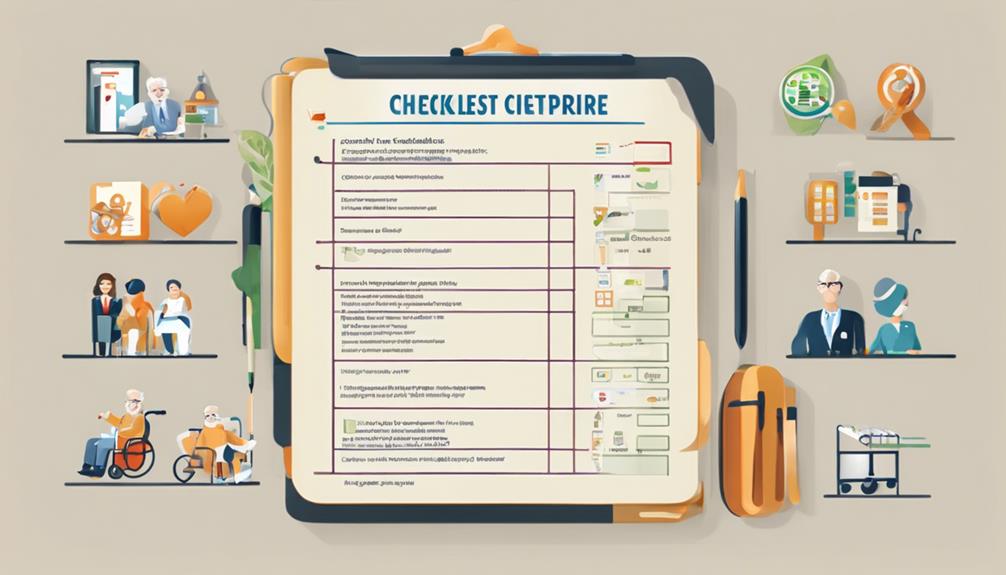
In New York, individuals must demonstrate a need for a nursing home level of care to qualify for the Assisted Living Program (ALP). This requirement guarantees that those who truly require the services provided by ALPs receive the necessary support.
ALP enrollment in New York is limited, meaning not all applicants may qualify for the program due to capacity constraints. To be eligible for ALP in New York, individuals must meet income limits, which are set at $1,732 per month for individuals and $3,464 per month for couples in 2024.
The ALPs in New York are closely regulated by the New York State Department of Health to ensure that residents receive high-quality care and services. Additionally, residents in Assisted Living Facilities (ALFs) in New York have the option to access Medicaid home health services for extra support if needed.
Meeting these criteria is crucial to proper enrollment in the ALP and receive the necessary care and assistance.
Enrollment Restrictions and Capacity Considerations
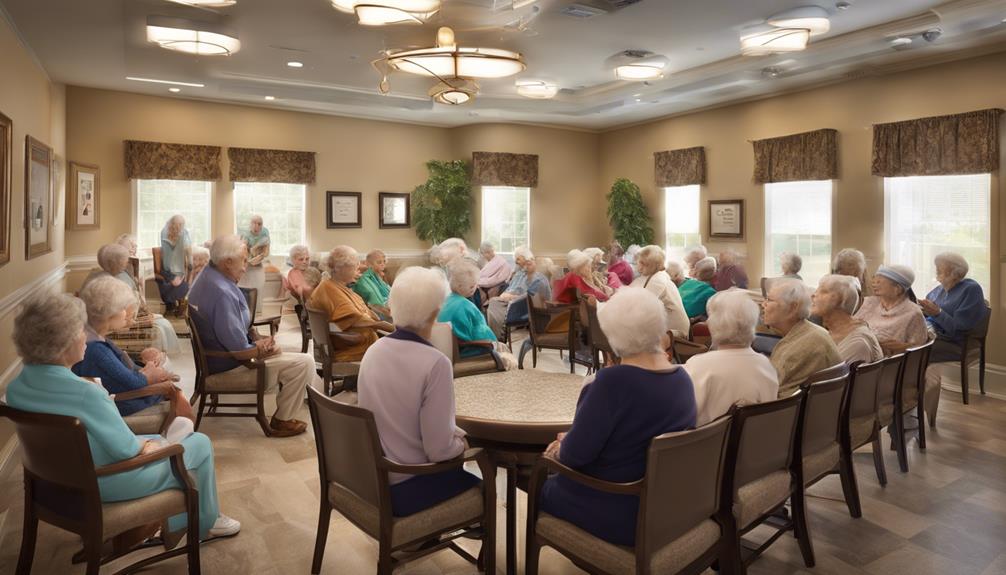
Considering the limited enrollment capacity of Assisted Living Programs (ALPs), individuals must meet strict criteria to secure a spot in the program. ALPs in New York, regulated by the New York State Department of Health, have specific income limits. For individuals, the income limit is $1,732 per month, while for couples, it's $3,464 per month.
To qualify for ALPs, individuals must demonstrate a need for a nursing home level of care. It's important to note that ALPs don't cover room and board costs. However, individuals may be able to seek assistance through Supplemental Security Income (SSI) to help cover these expenses.
Understanding the enrollment restrictions and capacity considerations of ALPs is essential for those looking to benefit from these programs. By meeting the income limits and demonstrating the required level of care need, individuals can take steps towards securing a place in an Assisted Living Program.
Understanding Essential Qualification Criteria
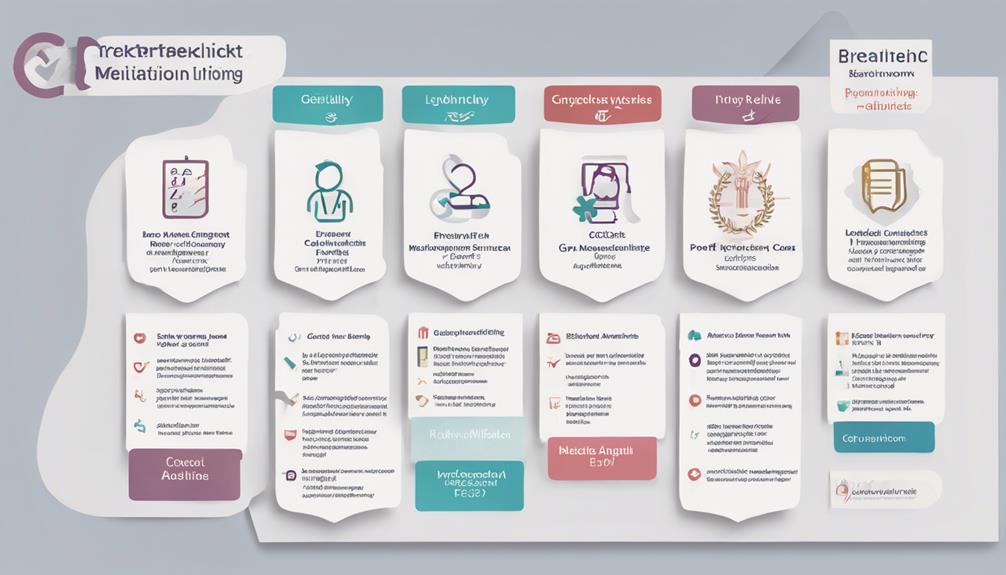
Moving from discussions regarding enrollment restrictions and capacity considerations, let's now focus on what individuals need to meet regarding essential qualification criteria for Assisted Living Programs (ALPs).
To qualify for Assisted Living, individuals must require support with daily living activities such as dressing, grooming, and meal preparation. It's important to have stable health conditions, typically manageable chronic illnesses, to be eligible for ALPs. However, individuals with severe dementia requiring memory care, those who are bedridden, or individuals needing around-the-clock nursing care may not meet the qualification criteria for Assisted Living.
Prospective residents may undergo physical assessments to determine their level of assistance needs and create personalized care plans tailored to their requirements. Additionally, providing a detailed medical history is often necessary for staff evaluation and the development of thorough care plans.
Assessment of Behaviors and Medical Needs

Assessing both behaviors and medical needs plays a crucial role in determining the level of care and support individuals require in an assisted living setting. Behavioral evaluations are conducted to guarantee compatibility with staff and residents, fostering a harmonious community atmosphere.
On the other hand, medical needs assessments cover a variety of aspects including existing conditions, required medications, and specific care needs essential for personalized care plans. These assessments are based on thorough evaluations that help in creating a tailored approach to meet the unique requirements of each resident.
Financial Planning and Assistance Options

Exploring various financial planning and assistance options is essential for individuals seeking to navigate the costs associated with assisted living facilities.
In New York, Assisted Living Programs (ALPs) have specific income limits set at $1,732 per month for individuals and $3,464 per month for couples in 2024. Supplemental Security Income (SSI) can aid in covering room and board expenses for ALP residents. To qualify for ALPs, individuals must demonstrate a need for a nursing home level of care. Additionally, ALPs in New York are licensed to accept Medicaid residents, enabling access to Medicaid home health services.
Understanding these financial aspects is vital for prospective residents and their families to plan effectively for the expenses associated with assisted living. By exploring options like SSI and Medicaid, individuals can better prepare for the financial obligations of residing in an ALP while ensuring they meet the necessary income limits and care requirements.
Frequently Asked Questions
What Are the Three Principles of Assisted Living?
We believe the three principles of assisted living are stability, independence, and tailored services. These principles focus on providing predictability, promoting autonomy, and offering personalized care plans to guarantee residents' needs are met thoroughly and compassionately.
Who Qualifies for Assisted Living in New York?
We qualify for assisted living in New York by demonstrating a need for a nursing home level of care. The income limits are $1,732 per month for individuals and $3,464 per month for couples. ALP enrollment is limited, ensuring quality care.
What Are the Three Characteristics That Refer to an Assisted Living Facility?
We believe assisted living facilities offer a blend of independence and care, emphasizing quality of life for seniors. These places provide housing, personal assistance, and promote social connections. Residents receive support with daily tasks to maintain independence.
Will Medicaid Pay for Assisted Living in New York State?
Yes, Medicaid may cover assisted living in New York State. It's essential to meet the required level of care and income limits. Room and board costs are typically not included, but SSI assistance might help with expenses.
Conclusion
To sum up, meeting the essential criteria for assisted living qualification is like finding your way through a maze – it requires careful planning and attention to detail. By demonstrating a need for nursing home level of care, meeting income thresholds, and fulfilling specific state requirements, individuals can access the support they need.
Understanding these criteria and exploring financial assistance options are key steps in the process. Just like a map guides us through unknown territory, these qualifications can lead individuals to the right path towards assisted living services.
Albert brings a wealth of knowledge and expertise to our writing team. With a background in caregiving and a deep understanding of the challenges faced by caregivers, Albert’s writing resonates with authenticity and empathy. He is committed to delivering high-quality content that empowers and supports caregivers on their journey.
-

 Dementia Care3 months ago
Dementia Care3 months agoUnderstanding the Stages of Vascular Dementia: A Visual Chart Guide
-

 Dementia Care3 months ago
Dementia Care3 months agoUnderstanding Narcissism and Dementia: A How-To Guide
-

 End of Life Issues1 month ago
End of Life Issues1 month agoHow to Comfort Someone in Hospice: What to Say
-

 Dementia Care3 months ago
Dementia Care3 months agoHow to Deal with a Parent’s Dementia: A Practical Guide
-

 Dementia Care3 months ago
Dementia Care3 months agoDavid Suchet’s Wife Opens Up About Living with Dementia
-

 Behavior Modification4 weeks ago
Behavior Modification4 weeks agoHow UTIs Can Cause Hallucinations: A Complete Guide
-

 Dementia Care2 months ago
Dementia Care2 months agoUnderstanding the Link Between Ambien and Dementia: A How-To Guide
-

 Dementia Care3 months ago
Dementia Care3 months ago10 Engaging Games for People with Dementia
